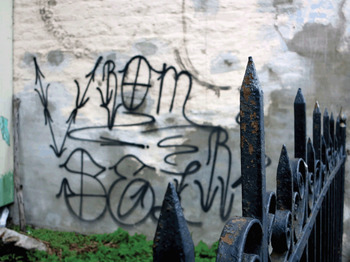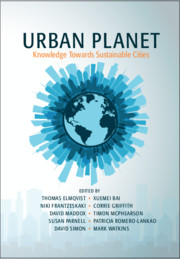Imagine a baleen whale: immense, rendered in black and white, with a sliver of red – animated, yet evidently butchered – emerging from the meeting of brick and spackled walls. A spout of black liquid rises from its blowhole, its presence startling in an otherwise empty parking lot. Figure 33.1 is the work of Belgian artist ROA: aerosol paint applied meticulously in thin lines against exterior walls in the small coastal city of Stavanger, Norway. The piece is site-specific, sharply referencing to the Nordic welfare state as hunters of whales made rich by the discovery of oil. Is it possible to appreciate ROA’s whale in the absence of this knowledge of media, artist, and context? What if you mistakenly believe whales to be fish? Must you know that it is a mammal to appreciate its grandeur, its whaleness? Would your aesthetic appreciation be augmented if you knew whales to be mammals, members of the Cetacean order, related to dolphins and porpoises?

Figure 33.1 Mural created by ROA for the 2013 Nuart Festival in Stavanger, Norway.
Environmental philosopher Carlson (Reference Carlson1984) argues that knowledge of taxonomy is fundamental to the appreciation of a whale, that scientific knowledge is vital to the aesthetic appreciation of nature (Brady Reference Brady1998). Carlson’s positive aesthetics likens the aesthetic appreciation of nature to the appreciation of art and suggests that, like art, all nature can be beautiful if only you possess the right knowledge. Applying this logic to the urban environment, the following discussion suggests that a positive aesthetics approach may lead to greater appreciation of tagging and graffiti and its cultural and political significance. An aesthetic appreciation for tagging may facilitate more informed and creative graffiti policy in cities and allow for more democratic use of public space.
The figurative nature of street art and new muralism, such as ROA’s work, lends itself to aesthetic appreciation. It is easy to understand, admire, and respect. Tagging, on the contrary, is frequently maligned. It is a form of graffiti that involves writing a name in a consistent style in as many locations as possible. It has been linked to social disorder due to myths of moral panic and the “broken windows theory,” which has inspired strict anti-graffiti policies in many cities (Young Reference Young2014). Negative opinions of tagging have been shaped by a public conditioning carefully constructed by media and politicians, what Cresswell (Reference Cresswell1992: 332) describes as a “discourse of disorder.” In such policy climates, there is no good or bad graffiti: there is only bad graffiti (Iveson Reference Iveson2009). Such approaches do not accommodate aesthetic appreciation.
Aesthetic appreciation may also be fueled by experience, perception, intuition, and imagination, as Brady (Reference Brady1998) suggests for the aesthetic appreciation of nature. This type of appreciation, however, comes more easily with the representational and figurative. Appreciation for tagging may require more, including a breaking free of conventional social, cultural, and political constructions of urban space. This requires something of the viewer: a shift of mind and a thoughtful reconsidering. A positive aesthetic approach may enhance appreciation of tags by encouraging the viewer to consider encountered pieces more carefully and thoughtfully.
Though they may seem indecipherable, tags are replete with meaning and made with skill and artistry. The tags of many graffiti writers are highly diverse in style and media, are spatially distributed throughout the city – indicative of profound knowledge of the geography of cities – and reflect calligraphic technique and a sense of design. Many tags are site-specific, sometimes mirroring aspects of the urban landscape (Figure 33.2). There is a beauty to tags, proficiently executed, mindfully placed, betraying hidden respect for the landscape. There is also beauty in the collective expression that arises anonymously, in saturated and incremental collaborations that build up gradually (Figure 33.3). Challenging our views and fostering aesthetic appreciation may make policy-makers of us all, contribute to shifts in public opinion, acknowledge tagging and graffiti as forms of urban art, and open the city up for more democratic and creative expression and policy. As cities become increasingly commodified and citizens long for more free artistic and political expression, this type of appreciation and shift may be fundamental to creating more just and inclusive communities.

Figure 33.2 A tag by Vrom Seier mimics the adjacent wrought-iron fence in Oslo, Norway.

Figure 33.3 Various tags in Stavanger, Norway.




